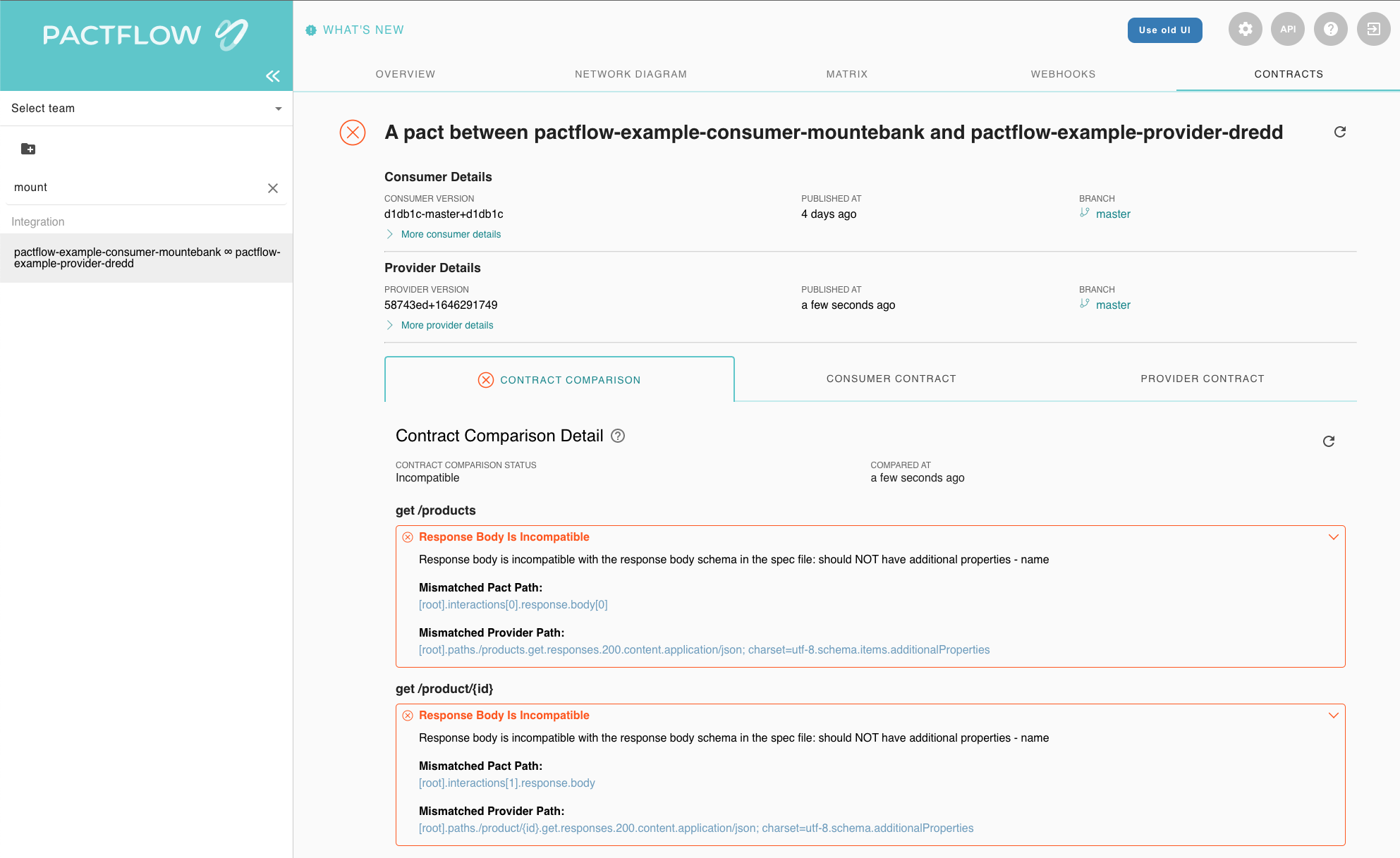10. Breaking change detection
So far everything has been really easy. Let's go a bit deeper and introduce a breaking change into the system. Breaking changes come in two main ways:
- A consumer can add a new expectation (e.g. a new field/endpoint) on a provider that doesn't exist
- A provider might make a change (e.g. remove or rename a field) that breaks an existing consumer
PactFlow will detect such situations using the can-i-deploy tool. When it runs, it performs a contract comparison that checks if the consumer contract is a valid subset of the provider contract in the target environment.
Let's see it in action.
Provider breaking changes
Change directories into cd /root/example-bi-directional-provider-dredd
Try changing the provider code in a backwards incompatible way, what happens?
// First comment out the 'price' key in the product.js file and from the OAS, then run
npm t
npm run publish
npm run can-i-deploy
OK, that was a trick! Note how in the consumer's Product definition, it doesn't actually use the price field? PactFlow knows all of the consumers needs down to the field level. Because no consumer uses price this is a safe operation.
Revert the change git checkout --
- Try changing the provider code in a way that will break it's existing consumer. For example, comment out all references to
namein the OAS and run the steps from above:
✗ npm run can-i-deploy
> product-service@1.0.0 can-i-deploy /Users/matthewfellows/development/public/pactflow-example-bi-directional-provider-dredd
> pact-broker can-i-deploy --pacticipant pactflow-example-bi-directional-provider-dredd --version="$(npx @pact-foundation/absolute-version)" --to-environment production
npx: installed 47 in 1.509s
Computer says no ¯_(ツ)_/¯
CONSUMER | C.VERSION | PROVIDER | P.VERSION | SUCCESS? | RESULT#
-------------------------------------|--------------------|---------------------------------|------------------------------------------|----------|--------
pactflow-example-consumer-mountebank | 5009e94+1645930887 | pactflow-example-bi-directional-provider-dredd | aec911-master+aec911.SNAPSHOT.Matts-iMac | false | 1
VERIFICATION RESULTS
--------------------
1. https://testdemo.pactflow.io/hal-browser/browser.html#https://testdemo.pactflow.io/contracts/provider/pactflow-example-bi-directional-provider-dredd/version/aec911-master%2Baec911.SNAPSHOT.Matts-iMac/consumer/pactflow-example-consumer-mountebank/pact-version/908c12f39ad2e9d9b31ff82a367f6e68368344b3/verification-results (failure)
The cross contract verification between the pact for the version of pactflow-example-consumer-mountebank currently deployed to production (5009e94+1645930887) and the oas for version aec911-master+aec911.SNAPSHOT.Matts-iMac of pactflow-example-bi-directional-provider-dredd failed
If you head into the PactFlow UI and drill down into the "contract comparison" tab, you'll see the output from comparing the consumer and provider contracts:

As you can see, it's alerting us to the fact that the consumer needs a field name but the provider doesn't support it.
Read more about how to interpret failures.
Consumer breaking changes
Change directories into your consumer project: cd /root/example-bi-directional-consumer-mountebank
Try adding a new expectation on the provider by updating the contract. For example, add a new property to the
expectedProductfield inexample-bi-directional-consumer-mountebank/src/api.spec.js:npm t
npm run publish
npm run can-i-deploy
You shouldn't be able to deploy!
✗ npm run can-i-deploy
> consumer@0.1.0 can-i-deploy /Users/matthewfellows/development/public/pactflow-example-consumer-mountebank
> pact-broker can-i-deploy --pacticipant pactflow-example-consumer-mountebank --version="$(npx @pact-foundation/absolute-version)" --to-environment production
npx: installed 47 in 2.64s
Computer says no ¯_(ツ)_/¯
CONSUMER | C.VERSION | PROVIDER | P.VERSION | SUCCESS? | RESULT#
-------------------------------------|------------------------------------------|---------------------------------|--------------------|----------|--------
pactflow-example-consumer-mountebank | 009e94-master+009e94.SNAPSHOT.Matts-iMac | pactflow-example-bi-directional-provider-dredd | caec911+1645930967 | false | 1
VERIFICATION RESULTS
--------------------
1. https://testdemo.pactflow.io/hal-browser/browser.html#https://testdemo.pactflow.io/contracts/provider/pactflow-example-bi-directional-provider-dredd/version/caec911%2B1645930967/consumer/pactflow-example-consumer-mountebank/pact-version/a34e535ec10e8c1fd04202ae4b9d3943b780c332/verification-results (failure)
The cross contract verification between the pact for version 009e94-master+009e94.SNAPSHOT.Matts-iMac of pactflow-example-consumer-mountebank and the oas for the version of pactflow-example-bi-directional-provider-dredd currently deployed to production (caec911+1645930967) failed
As per the previous failure, you can see it's alerting us to the fact that the consumer needs a field colour but the provider doesn't support it.
The consumer won't be able to release this change until the Provider API supports it.
Check your understanding
- It is always safe to remove a field from a provider, if no consumers are currently using it
- It is not safe to remove a field/endpoint from a provider, if an existing consumer is using it, and PactFlow will detect this situation.
- PactFlow will prevent a consumer from deploying a change that a Provider has yet to support
Further material
You may be interested in a dive into our CI/CD workshop with Pact and the consumer driven contract testing approach